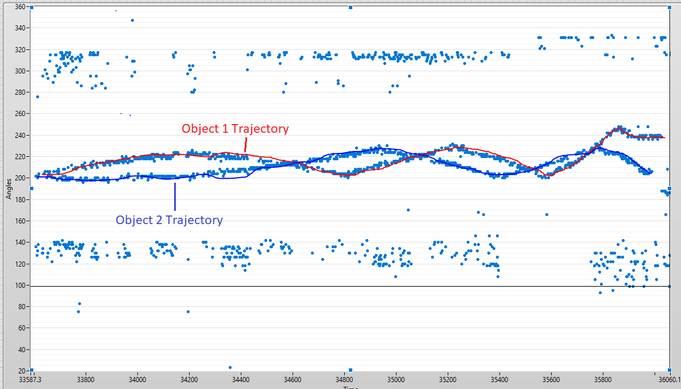- Subscribe to RSS Feed
- Mark Topic as New
- Mark Topic as Read
- Float this Topic for Current User
- Bookmark
- Subscribe
- Mute
- Printer Friendly Page
- « Previous
-
- 1
- 2
- Next »
Tracking / Classification / Extracting Objects Trajectory Data Points
11-25-2021 09:49 PM
- Mark as New
- Bookmark
- Subscribe
- Mute
- Subscribe to RSS Feed
- Permalink
- Report to a Moderator
Thanks to All for your Positive Responses and Suggestion its been really Helpful to me
The Data Points are Object/Target Angles actually which were Recorded on a specific time and Logged in a Text File. it has Multiple Objects Trajectories and also contain False Alarms
I am trying to Track Object Trajectories currently I am trying to implement Single Target Tracking and in Future will Move to Multiple Target Tracking. The Conceptual Block Diagram is Shown Below
So far, I tried to Implement it by selecting point on a graph via double click which is starting point and then I tried to Track it by Calculating Distance and associate Points based on Minimum Distance
The 2 lines which I Highlighted in above figure are 2 Objects Trajectories which cross each other Multiple times. I am trying to Separate and also extract true path of these trajectories from each other.
I have improved my Previous Version of Code and remove the bugs hopefully I will succeed soon.
Thanks to all and Looking forward Positive Response from you
11-25-2021 09:51 PM
- Mark as New
- Bookmark
- Subscribe
- Mute
- Subscribe to RSS Feed
- Permalink
- Report to a Moderator
Thanks to All for your Positive Responses and Suggestion its been really Helpful to me
The Data Points are Object/Target Angles actually which were Recorded on a specific time and Logged in a Text File. it has Multiple Objects Trajectories and also contain False Alarms
I am trying to Track Object Trajectories currently I am trying to implement Single Target Tracking and in Future will Move to Multiple Target Tracking. The Conceptual Block Diagram is Shown Below
So far, I tried to Implement it by selecting point on a graph via double click which is starting point and then I tried to Track it by Calculating Distance and associate Points based on Minimum Distance
The 2 lines which I Highlighted in above figure are 2 Objects Trajectories which cross each other Multiple times. I am trying to Separate and also extract true path of these trajectories from each other.
I have improved my Previous Version of Code and remove the bugs hopefully I will succeed soon.
Thanks to all and Looking forward Positive Response from you
11-26-2021 08:11 AM
- Mark as New
- Bookmark
- Subscribe
- Mute
- Subscribe to RSS Feed
- Permalink
- Report to a Moderator
@mrjunaidkahn wrote:
So far, I tried to Implement it by selecting point on a graph via double click which is starting point and then I tried to Track it by Calculating Distance and associate Points based on Minimum Distance
You are limited by geometry.
If you pick those 2 initials datapoints:
using your code, this will separate the raw data well into 2 categories in the range
33700 to 34400, as the trajectories don't overlap.
the data in range 34400 to 34650 can't be separated, as the trajectories overlap, there is no difference, the datapoints are identical for trajectory 1 & 2.
when you tap into a range like this, how should you ever be able to separate again, using only the minimum distance to the next datapoint?
if the initial x,y pairs are identical, their minimum distance to the next datapoint will be identical.
you need another criterium, and you need to check, when to apply this criterium.
11-26-2021 11:56 AM
- Mark as New
- Bookmark
- Subscribe
- Mute
- Subscribe to RSS Feed
- Permalink
- Report to a Moderator
What I would probably do is keep only the sections where the traces really differ (trace A, trace B) and for each pair of adjacent sections, fit all possible parings of sections to a low order polynomial. If swapping A and B of the second set give an overall better fit, swap, else don't. Repeat for all adjacent sections. At the end, you'll have trace A and B, each following their respective data. Try it!
- « Previous
-
- 1
- 2
- Next »





